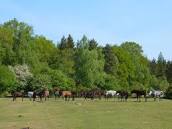The use of sulpride to advance first ovulation in transitional mares
Artificial photoperiod treatment is currently the best method to hasten the first ovulation of the breeding season in winter anoestrus mares. However, this is not easy to apply in large herds of mares and, to be effective, has to be planned in the northern hemisphere in December at the latest. Pharmacological treatments have been proposed as alternatives: GnRH agonists, progesterone or its synthetic agonist Altrenogest, and dopamino-antagonists, as pherphenazine, domperidone or sulpiride. Dopamino-antagonists protocols, beginning at a given day of the year, gave controversial results in terms of hastening ovulation. The aim of this study was to evaluate the efficacy of an up-to-21-d long dopamine antagonist (sulpiride) treatment on mares at the beginning of the spring transition for its ability to hasten estrous cyclicity. In Study 1, 49 seasonally-acyclic standardbred mares, maintained in paddocks under natural photoperiod, were treated with 1 mg/kg/d sulpiride at the evidence of the first follicle with of 25 mm in diameter until ovulation for a maximum of 21 d (Group S1; n = 34) or left untreated (Group C1; n = 15). Group S1 and C1 mares showed a follicle of 35 mm in diameter after 8 and 22 d (median; P < 0.05) and ovulated after 18 and 43 d, respectively (median; P < 0.05). Twenty-two/26 and 6/15 mares of the Group S1 and C1 ovulated within 30 d from the beginning of the treatment, respectively (P < 0.05). All the mares of the study cycled until Autumn, unless they became pregnant.
In Study 2, pregnancy rates after the first ovulation of the year of 22 acyclic standardbred mares maintained in paddocks under natural photo-period, treated following the same protocol as Study 1 (S2), and 47 untreated mares (C2) were compared. In Groups S2 and C2, 63.6% and 61.7% of the mares became pregnant after the first cycle (P > 0.05) and 50.0% and 61.1% of the remaining became pregnant in the following cycles (P > 0.05), respectively.
Beginning with sulpiride treatment when follicles were 25 mm in diameter resulted in a significant advancement of cyclicity in non-photo-stimulated mares. Pregnancy rates after artificial insemination of treated mares were similar to those of untreated animals.
Please click here to be directed to the study.

